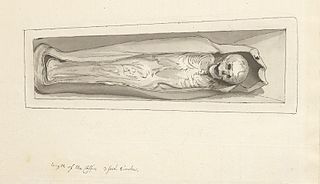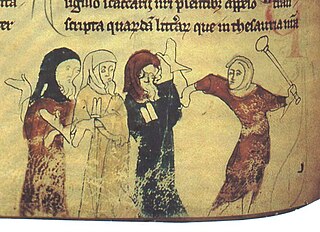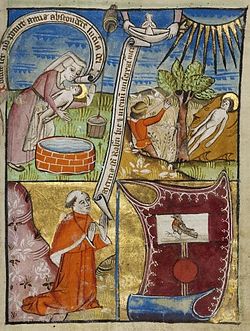
The Benedictines, officially the Order of Saint Benedict, are a mainly contemplative monastic religious order of the Catholic Church for men and for women who follow the Rule of Saint Benedict. The male religious are also sometimes called the Black Monks, in reference to the colour of their religious habits, in contrast to other Benedictine orders such as the Olivetans, who wear white. They were founded in 529 by Benedict of Nursia, a 6th-century Italian monk who laid the foundations of Benedictine monasticism through the formulation of his Rule. Benedict's sister, Scholastica, possibly his twin, also became religious from an early age, but chose to live as a hermit. They retained a close relationship until her death.

Blood libel or ritual murder libel is an antisemitic canard which falsely accuses Jews of murdering Christians in order to use their blood in the performance of religious rituals. Echoing very old myths of secret cultic practices in many prehistoric societies, the claim, as it is leveled against Jews, was rarely attested to in antiquity. According to Tertullian, it originally emerged in late antiquity as an accusation made against members of the early Christian community of the Roman Empire. Once this accusation had been dismissed, it was revived a millennium later as a Christian slander against Jews in the medieval period. The first examples of medieval blood libel emerged in England in the mid 1100s before spreading into other parts of Europe, especially France and Germany. This libel, alongside those of well poisoning and host desecration, became a major theme of the persecution of Jews in Europe from that period down to modern times.

St Benet's Abbey, also known as St Benet's at Holme or St Benet Hulme, was a medieval monastery of the Order of Saint Benedict situated at Cow Holm in Horning, Norfolk, England. It lay on the River Bure within the Broads. St Benet is a medieval English version of the name of St Benedict of Nursia, hailed as the founder of western monasticism. At the period of the Dissolution of the Monasteries the abbey's possessions were in effect seized by the crown and assigned to the diocese of Norwich. Though the monastery was supposed to continue as a community, within a few years at least the monks had dispersed. Today there remain only ruins.

Edmund the Martyr was king of East Anglia from about 855 until his death.

Hugh of Lincoln was an English boy whose death in Lincoln was falsely attributed to Jews. He is sometimes known as Little Saint Hugh or Little Sir Hugh to distinguish him from the adult saint, Hugh of Lincoln. The boy Hugh was not formally canonised, so "Little Saint Hugh" is a misnomer.

Bury St Edmunds, commonly referred to locally as Bury, is a historic market and cathedral town and civil parish in the West Suffolk district, in the county of Suffolk, England. The town is best known for Bury St Edmunds Abbey and St Edmundsbury Cathedral. Bury is the seat of the Diocese of St Edmundsbury and Ipswich of the Church of England, with the episcopal see at St Edmundsbury Cathedral. In 2011 it had a population of 45,000.

William of Norwich was an apprentice who lived in the English city of Norwich. He suffered a violent death during Easter 1144. The city's French-speaking Jewish community was blamed for his death, but the crime was never solved. William's case is the first known example of a medieval blood libel.

The Edict of Expulsion was a royal decree expelling all Jews from the Kingdom of England that was issued by Edward I 18 July 1290; it was the first time a European state is known to have permanently banned their presence. The date of issuance was most likely chosen because it was a Jewish holy day, the ninth of Ab, which commemorates the destruction of Jerusalem and other disasters the Jewish people have experienced. Edward told the sheriffs of all counties he wanted all Jews expelled before All Saints' Day that year.

The first Jews in England arrived after the Norman Conquest of the country by William the Conqueror in 1066, and the first written record of Jewish settlement in England dates from 1070. Jews suffered massacres in 1189–90, and after a period of rising persecution, all Jews were expelled from England after the Edict of Expulsion in 1290.

The Abbey of Bury St Edmunds was once among the richest Benedictine monasteries in England, until its dissolution in 1539. It is in the town that grew up around it, Bury St Edmunds in the county of Suffolk, England. It was a centre of pilgrimage as the burial place of the Anglo-Saxon martyr-king Saint Edmund, killed by the Great Heathen Army of Danes in 869. The ruins of the abbey church and most other buildings are merely rubble cores, but two very large medieval gatehouses survive, as well as two secondary medieval churches built within the abbey complex.
Jocelyn or Jocelin de Brakelond or Brakelonde was an English Benedictine monk at Bury St. Edmunds Abbey in Suffolk, England. He is only known through his work, the Chronicle of the Abbey of St. Edmunds, which narrates the fortunes of the monastery during the years from 1173 to 1202.
William de Turbeville was a medieval Bishop of Norwich.
Events from the 1140s in England.

Anderl (Andreas) Oxner von Rinn, also known as Andreas Oxner, is a folk saint of the Roman Catholic Church. A later writer alleged that the three-year-old boy had been ritually murdered by the Jews in the village of Rinn. The story is an example of a Blood libel common in medieval Europe.
Samson of Tottington (1135–1211) was an English Benedictine monk who became Abbot of Bury St Edmunds. He oversaw the expulsion of Jews from Bury St Edmunds after a 1190 pogrom during Holy Week. His life was later used by Thomas Carlyle as a leadership model in his book Past and Present.

Harold of Gloucester was a supposed child martyr who was falsely claimed by Benedictine monks to have been ritually murdered by Jews in Gloucester, England, in 1168. The claims arose in the aftermath of the circulation of the first blood libel myth following the unsolved murder of William of Norwich. A Christian cult and veneration of Harold was briefly promoted in Gloucester, but soon died out.

Werner of Oberwesel was a 16-year-old boy whose unexplained death was blamed on Jews, leading to revenge killings of Jews across Europe. He was venerated as a Christian saint, and his memorial day was 19 April.
The Life and Miracles of St William of Norwich is a Latin hagiography of William of Norwich by the Benedictine monk Thomas of Monmouth that was written in the second half of the twelfth century. It puts forth the false claim that a young boy named William, who had been found dead in a forest, was in fact ritually murdered by Jews, and was therefore eligible for sainthood.
Baldwin was a French monk and royal physician. He became a monk in France before coming to England to serve as King Edward the Confessor's doctor. He served as a prior before becoming abbot of Bury St Edmunds in 1065. As abbot he promoted the cult of Edmund the Martyr and secured the abbey's independence from the bishops of Thetford. He continued to serve as royal physician to two more kings of England and also rebuilt parts of the abbey before dying around 1097.












